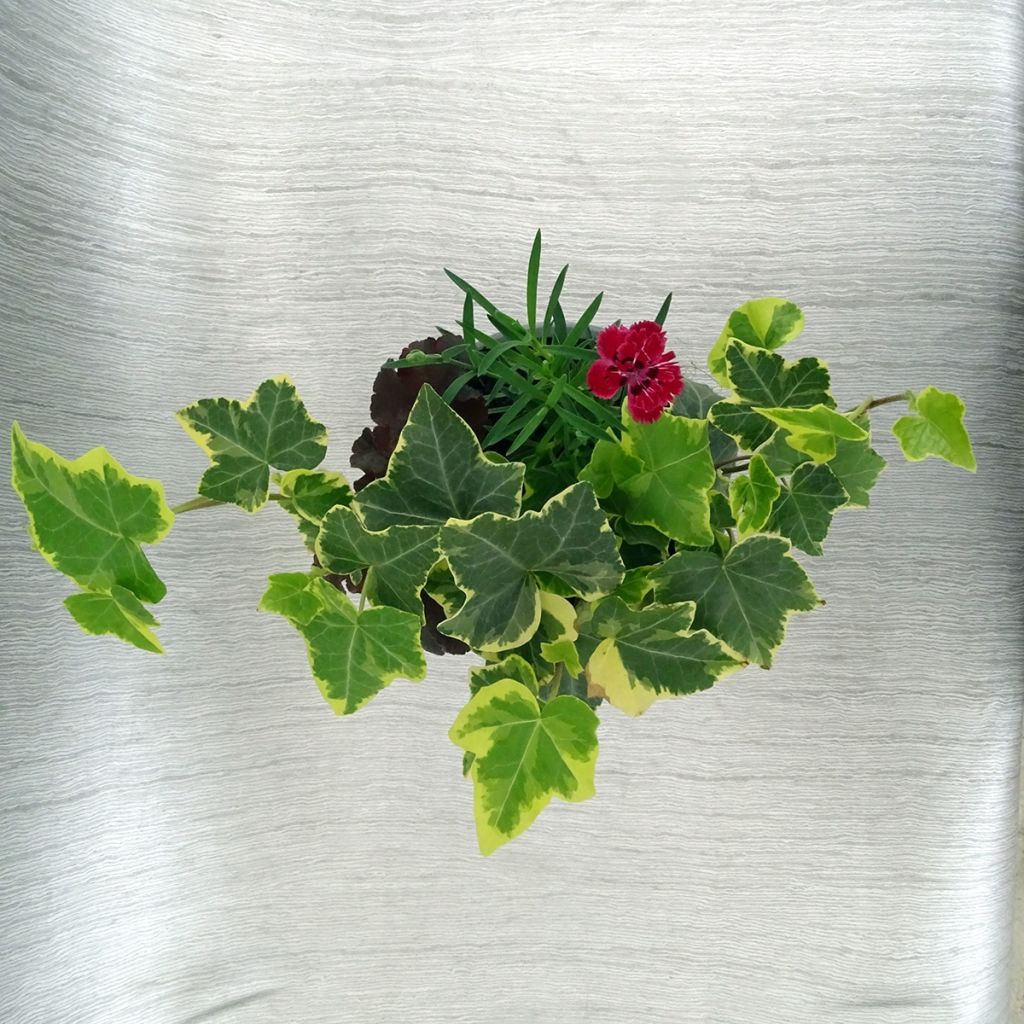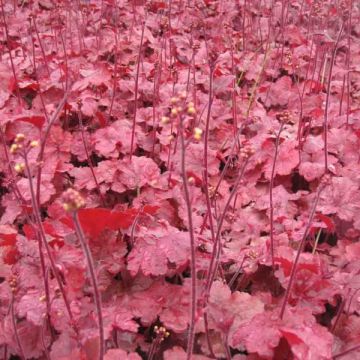

Lucky Charm Blend - blend of 3 young plants


Lucky Charm Blend - blend of 3 young plants


Lucky Charm Blend - blend of 3 young plants
Lucky Charm Blend - blend of 3 young plants
Dianthus, Heuchera, Hedera
This composition is splendid with the heuchera, the carnations, and the ivy. The young plants are tall and robust and have not suffered from transportation.
cricri, 30/11/2023
This plant carries a 6 months recovery warranty
More information
We guarantee the quality of our plants for a full growing cycle, and will replace at our expense any plant that fails to recover under normal climatic and planting conditions.
From €5.90 for pickup delivery and €6.90 for home delivery
Express home delivery from €8.90.

Does this plant fit my garden?
Set up your Plantfit profile →
Description
The Lucky Charm Blend from the Autumn Fairy collection flowers from spring to autumn and is decorative even in winter. One single container has three hardy and low-maintenance perennial plants, easy to grow in the ground and in pots. Textures and colours harmoniously combine, with the composition reaching its peak from June to July, with the small red carnations and delicate flower spikes of the heuchera. Already composed and ready to plant, this trio allows you to dress up your terrace or garden for an immediate and long-lasting, tasteful effect!
The Lucky Charm pot consists of:
- 1 x Dianthus or Merci Fleuri carnation: a perennial variety that is very hardy and compact, with an exceptionally long flowering period from April-May to October. Its small flowers have scarlet petals speckled with black at the base. The foliage persists in winter.
- 1 x Heuchera: caramel-coloured with pink and bronze reflections. This perennial plant blooms in summer, with extremely delicate floral spikes adorned with tiny white-pink bells. The foliage persists more or less in winter.
- 1 x Hedera: a small compact variety that produces long creeping stems. Its triangular and lobed green leaves are randomly edged with yellow and spotted with cream-white. They persist in winter.
Grown in the same pot, these perennial plants get along well, each finding its place without suffocating the others. They can be repotted in a larger container, such as a wide basin, to enhance them on the balcony or terrace. This composition can also be planted in the ground, in full sun or partial shade, in well-drained, rich and moist soil.
Report an error about the product description
Lucky Charm Blend - blend of 3 young plants in pictures


Flowering
Foliage
Plant habit
Botanical data
Dianthus, Heuchera, Hedera
Cultivar or hybrid
Other Heuchera
Planting and care
Plant your Lucky Charm Blend in spring or early autumn. Repot in a large container, such as a basin or planter, to allow the plants to reach their full potential. Use rich and light soil and water regularly. Apply universal fertilizer in spring. Choose a sunny or partially shaded exposure. The composition can withstand winter outside, as all the plants in it are hardy.
In open ground: if your soil is heavy, mix some compost and sand with it, partially refill and place your collection so that the top of the root balls are covered with 2-3 cm (1in) of soil. The addition of a base fertilizer will nourish your plants during the rooting period without the risk of burning. Firm the soil and water generously to eliminate air pockets. If the weather is dry, you will need to water regularly for a few weeks to aid establishment, then water if it is very dry. We recommend pruning dry leaves and stems in February-March.
Planting period
Intended location
Care
-
, onOrder confirmed
Reply from on Promesse de fleurs
Summer flowering perennials
Haven't found what you were looking for?
Hardiness is the lowest winter temperature a plant can endure without suffering serious damage or even dying. However, hardiness is affected by location (a sheltered area, such as a patio), protection (winter cover) and soil type (hardiness is improved by well-drained soil).

Photo Sharing Terms & Conditions
In order to encourage gardeners to interact and share their experiences, Promesse de fleurs offers various media enabling content to be uploaded onto its Site - in particular via the ‘Photo sharing’ module.
The User agrees to refrain from:
- Posting any content that is illegal, prejudicial, insulting, racist, inciteful to hatred, revisionist, contrary to public decency, that infringes on privacy or on the privacy rights of third parties, in particular the publicity rights of persons and goods, intellectual property rights, or the right to privacy.
- Submitting content on behalf of a third party;
- Impersonate the identity of a third party and/or publish any personal information about a third party;
In general, the User undertakes to refrain from any unethical behaviour.
All Content (in particular text, comments, files, images, photos, videos, creative works, etc.), which may be subject to property or intellectual property rights, image or other private rights, shall remain the property of the User, subject to the limited rights granted by the terms of the licence granted by Promesse de fleurs as stated below. Users are at liberty to publish or not to publish such Content on the Site, notably via the ‘Photo Sharing’ facility, and accept that this Content shall be made public and freely accessible, notably on the Internet.
Users further acknowledge, undertake to have ,and guarantee that they hold all necessary rights and permissions to publish such material on the Site, in particular with regard to the legislation in force pertaining to any privacy, property, intellectual property, image, or contractual rights, or rights of any other nature. By publishing such Content on the Site, Users acknowledge accepting full liability as publishers of the Content within the meaning of the law, and grant Promesse de fleurs, free of charge, an inclusive, worldwide licence for the said Content for the entire duration of its publication, including all reproduction, representation, up/downloading, displaying, performing, transmission, and storage rights.
Users also grant permission for their name to be linked to the Content and accept that this link may not always be made available.
By engaging in posting material, Users consent to their Content becoming automatically accessible on the Internet, in particular on other sites and/or blogs and/or web pages of the Promesse de fleurs site, including in particular social pages and the Promesse de fleurs catalogue.
Users may secure the removal of entrusted content free of charge by issuing a simple request via our contact form.
The flowering period indicated on our website applies to countries and regions located in USDA zone 8 (France, the United Kingdom, Ireland, the Netherlands, etc.)
It will vary according to where you live:
- In zones 9 to 10 (Italy, Spain, Greece, etc.), flowering will occur about 2 to 4 weeks earlier.
- In zones 6 to 7 (Germany, Poland, Slovenia, and lower mountainous regions), flowering will be delayed by 2 to 3 weeks.
- In zone 5 (Central Europe, Scandinavia), blooming will be delayed by 3 to 5 weeks.
In temperate climates, pruning of spring-flowering shrubs (forsythia, spireas, etc.) should be done just after flowering.
Pruning of summer-flowering shrubs (Indian Lilac, Perovskia, etc.) can be done in winter or spring.
In cold regions as well as with frost-sensitive plants, avoid pruning too early when severe frosts may still occur.
The planting period indicated on our website applies to countries and regions located in USDA zone 8 (France, United Kingdom, Ireland, Netherlands).
It will vary according to where you live:
- In Mediterranean zones (Marseille, Madrid, Milan, etc.), autumn and winter are the best planting periods.
- In continental zones (Strasbourg, Munich, Vienna, etc.), delay planting by 2 to 3 weeks in spring and bring it forward by 2 to 4 weeks in autumn.
- In mountainous regions (the Alps, Pyrenees, Carpathians, etc.), it is best to plant in late spring (May-June) or late summer (August-September).
The harvesting period indicated on our website applies to countries and regions in USDA zone 8 (France, England, Ireland, the Netherlands).
In colder areas (Scandinavia, Poland, Austria...) fruit and vegetable harvests are likely to be delayed by 3-4 weeks.
In warmer areas (Italy, Spain, Greece, etc.), harvesting will probably take place earlier, depending on weather conditions.
The sowing periods indicated on our website apply to countries and regions within USDA Zone 8 (France, UK, Ireland, Netherlands).
In colder areas (Scandinavia, Poland, Austria...), delay any outdoor sowing by 3-4 weeks, or sow under glass.
In warmer climes (Italy, Spain, Greece, etc.), bring outdoor sowing forward by a few weeks.























































